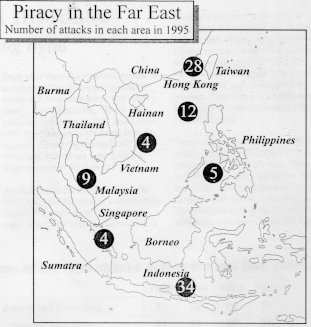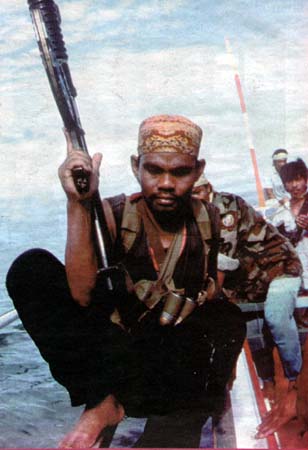 Piracy Hot Spots
Piracy Hot Spots 
"Taking a look at the hot-spots of attacks and piracy and you will see
that they all have one common denominator. . . the inability of local governments
to effect a timely and continued response against the perpetrators. . .
The simple fact is that, lines of territorial jurisdiction in most cases
prohibit an effective response by a single local government agency. It
raises the issue of the need for a concerted multi-national solution."1
"Only isolated incidents of high seas crime occur within the reach of organized
rescue and naval forces."2 For example, the United States has
had few incidents of maritime piracy within its territorial waters. This
is due to the fact that the United States Coast Guard and United States
Naval forces, when alerted, will respond to incidents and pursue the perpetrators
abroad. They have the means of sea and air transport to carry out these
pursuits, and the "diplomatic framework exists that enables the pursuit
to extend into the territorial waters of adjacent nations."3
This is a powerful deterrent to the potential attacker, and this is why
there are few piratical attacks near U.S. territorial waters.
As of June 1999, Southeast Asia, Africa, and Brazil ranked as the three
major “hot-spots” of piracy attacks:
"Areas of concern include the
South China Seas, West Africa, South America (particularly the ports of
Brazil), the coasts of the Arabian Peninsula, The Philippines, Indonesia,
Somalia and, with the chaos in Albania, even parts of the Mediterranean.
Over 200 crew have been assaulted, taken hostage or injured in attacks
this year, and eight killed. The figures also show that pirates are more
likely to be armed with guns than in previous years - in 21 incidents during
the first half of 1997, compared with 16 in the same period last year."4
South-East Asia
Southeast Asia retains its position as the most active region in regards
to attacks upon vessels. "More than half of all reported attacks occur
in this region, and they continue to increase in frequency."5
The entire region of Southeast Asia, including the South China Sea, is
currently considered a danger zone. "The waters off Indonesia, Malaysia,
and Singapore are the predominant areas of incident occurrence."6
Attacks have become especially prevalent in Asian waters, where "the absence
of naval power, coastal police patrols, cooperative law enforcement and
treaty agreements have made the shipping lanes a pirate's dream. Criminal
enterprises using sophisticated knowledge of the shipping industry, and
often aided by compliant local officials, can plunder with minimal risk.
In some cases, pirates have tied up the bridge crews of large oil tankers
and freighters, leaving the ships adrift and creating a scary potential
for grounding or collision and an environmentally disastrous oil spill."7
In this area, both commercial and yachting interests are being attacked
with increasing frequency. Small coastal tankers are becoming popular targets
as well, as their product can be easily sold to local villagers who operate
small vessels.
Malaysia and The Philippines
Piracy in Philippine waters has the probability of being exceptionally
violent. Although the total number of pirate attacks in Philippine waters
has decreased during the last two years, piracy in the area between Malaysian
and Philippine waters is once-again, on the rise.
China
Some of the piracy around Chinese waters has a quasi-official quality.
There is an appearance of official connivance. The suspicions of official
complicity have become so widespread and persistent that two years ago
China was forced to formally deny reports that its official agencies carried
out pirate attacks!
"Beijing told a United Nations
maritime safety official it rejected allegations that "the normal execution
of law enforcement duties by competent Chinese authorities constitutes
any form of unlawful act." It said its patrol boats were often simply trying
to crack smuggling cases when they approached other vessels. However China
has also acknowledged that some pirates may have copied the uniforms of
its navy and mimicked the colorings of official vessels."8
"In August 1994 China ordered strict punishment against those who "pretend
to be naval vessels and commit piracy at sea," the official People's Daily
said. However in 1995 and 1996 the pattern continued and Chinese vessels
still intercepted ships on the high seas and "escorted" them to port as
probable smugglers--after which the cargo was removed."9
Bangladesh
Some of the most lethal pirate attacks in the world have taken place in
the Bay of Bengal, off Bangladesh. As a result of the increasing number
of attacks in the waters of this region, the Bangladeshi navy and coast
guard agreed at the end of 1996 to patrol the port of Chittagong regularly.
"This move by the Bangladeshi Navy came only after crews of coasters and
lighter vessels refused to venture into the outer anchorage unless given
adequate protection."10
Indonesia
The greatest number of pirate attacks in 1996 was in Indonesia with 51
incidents, against 34 the previous year. Indonesia has seen a steady growth
in such attacks since 1993. "The Kuala Lumpur-based piracy information
center reports that anchored ships took the biggest hit in Indonesian waters.
According to the IMB center, of the 17 incidents reported in the archipelago
in the first five months of 1996, 16 of them involved ships in port."11
In all of the most recently reported attacks the pirates went for cash,
crew's valuables and ship's properties.
However, it should be noted that piracy in the Straits of Malacca has shown
a dramatic decline due to the efforts of the
Indonesians. There were 200 recorded
cases of piracy in the straits, which link the Indian Ocean to the South
China Sea and the Pacific Ocean, in 1991. The drop occurred after Malaysia,
Indonesia and Singapore began joint patrols of the waterway.
India
The IMB reports that in Calcutta ship traffic has been restricted to daylight
operations because of night pirate attacks.

Africa
On the coastal waters surrounding the continent of Africa, the majority
of piratical attacks occurred in "the vicinity of Nigeria, Somalia, and
Sierra Leone, and nearly all were within territorial waters."12
Numerous shore-based incidents have occurred involving nighttime attacks
against anchored, stationary vessels. "More than two thirds of the attacks
targeted anchored vessels. Attacker success rate was 95% or higher."13
Somalia
In Somalia, vessel masters are urged to plot courses that keep them at
least 50 miles offshore. Somalia continues to remain a high-threat area
for both commercial and yachting vessels. "Militia factions will use mortars,
shoulder-fired rockets, and small arms to intimidate and attack vessels.
They will pursue and intercept vessels using high-speed launches . . .
The militiamen routinely seize foreign vessels and hold the vessel and
crew hostage until a ransom is paid."14
The identity of the Somali pirates is a major question. "Pirates in Somalian
waters have sometimes misrepresented themselves as the Somali coast guard.
Like the Chinese, there is evidence indicating that Somali government officials
and Coast Guard Officials are participating in these crimes of the sea.
"Compounding the problem of dealing with piracy in Somali waters is the
fact that the country has not had a central government since the overthrow
of late dictator Mohamed Siad Barre in 1991."15
Sierra Leone
Sierra Leone has turned into a new, mini-hotspot. It, like China and Somalia,
seems to have a quasi-official tinge and soldiers are known for robbing
both boats and cars. "The situation deteriorated so much that in October
1996 fishermen working off Sierra Leone struck to protest a surge in piracy
there, but called off the work stoppage after a navy patrol arrested five
soldiers caught raiding a fishing vessel, fisheries officials said. The
capture of the soldiers at Banana Island near Freetown prompted the 1,500
fishing workers to call off a 10-day-old strike intended to put pressure
on the government to act against mounting piracy on fishing vessels off
Sierra Leone. The work stoppage was an international affair--the striking
trawler workers were from Sierra Leone, Senegal, Guinea Bissau, Spain,
Portugal and South Korea."16
Latin America
Brazil
Brazil is the number one hotspot for attacks against commercial vessels,
which primarily occur in the waters surrounding Rio de Janeiro. "Piratical
attacks in Brazilian waters tend to be against anchored vessels where
valuables and cash are usually targeted. Violence remains high per incident
in these coastal waters."17
In 1996 Brazilian waters had the distinction of being the second- most
pirate-plagued waters in the world, with 15 cases of piracy reported. The
attackers are usually heavily armed. In addition to the pattern that the
majority of piratical attacks occurred off anchorages, and the pirates
were reported to be armed, there was another pattern: Radio calls made
to port authorities were met with very little, to no response.
"The 1996 Annual Maritime Piracy Report warned that Brazil needed to control
the issues of maritime piracy and robbery, but over the years, the Brazilian
government has proven indifferent to the problem. "Brazil remains a highly
dangerous area and this will continue to be so as long as the authorities
fail to acknowledge the situation,'' it said."18
Other Latin American Countries
and the Caribbean
"The Colombia/Venezuela border at the Caribbean Sea is an area of extreme
risk to yachts making passage to and from Aruba or along the coasts of
Colombia and Venezuela,"14 as are the coasts of Nicaragua, Costa
Rica, and the majority of the islands in the Caribbean, where there are
piratical attacks of gangsters and Mafiosos raiding ships for the sole
purpose of obtaining the narcotics they are carrying on board. In these
areas, fishing vessels and yachts are also often attacked.
Mediterranean
The predominant attacks in this area occur against coastal fishing vessels
and yachts. The western coastal waters of Greece, particularly the Greek
Island of Corfu, are the prime areas of piratical attacks and robberies.
Many of these attacks have been linked to Albanian bandits, "who conduct
their attacks while armed with automatic weapons and grenades."15
Violence
is very common during these attacks.
FOOTNOTES:
1.
Kellerman, David N. "Worldwide Maritime Piracy Report: June 1999." www.maritimesecurity.com
2.
Kellerman, David N. "Worldwide Maritime Piracy Report: June 1999." www.maritimesecurity.com
3.
Kellerman, David N. "Worldwide Maritime Piracy Report: June 1999." www.maritimesecurity.com
4.
Ryan, Nick. "The Return of The Pirates." http://www.foreignwire.com/pirates.html
5.
Kellerman, David N. "Worldwide Maritime Piracy Report: June 1999." www.maritimesecurity.com
6.
Kellerman, David N. "Worldwide Maritime Piracy Report: June 1999." www.maritimesecurity.com
7.
Grissim, John. The Washington Post. "Modern-Day Pirates Are Terrorizing
the High Seas." Sunday, June 22, 1997; Page C01. http://paladin-san-francisco.com/pirac2.htm
8.
Monday, Mark and Gary Stubblefield. "Piracy--An Old Profession." http://paladin-san-francisco.com/libpirac.htm
9.
Monday, Mark and Gary Stubblefield. "Piracy--An Old Profession." http://paladin-san-francisco.com/libpirac.htm
10.
Monday, Mark and Gary Stubblefield. "Piracy--An Old Profession." http://paladin-san-francisco.com/libpirac.htm
11.
Monday, Mark and Gary Stubblefield. "Piracy--An Old Profession." http://paladin-san-francisco.com/libpirac.htm
12.
Kellerman, David N. "Worldwide Maritime Piracy Report: June 1999." www.maritimesecurity.com
13.
Kellerman, David N. "Worldwide Maritime Piracy Report: June 1999." www.maritimesecurity.com
14.
Kellerman, David N. "Worldwide Maritime Piracy Report: June 1999." www.maritimesecurity.com
15.
Monday, Mark and Gary Stubblefield. "Piracy--An Old Profession." http://paladin-san-francisco.com/libpirac.htm
16.
Monday, Mark and Gary Stubblefield. "Piracy--An Old Profession." http://paladin-san-francisco.com/libpirac.htm
17.
Kellerman, David N. "Worldwide Maritime Piracy Report: June 1999." www.maritimesecurity.com
18.
Monday, Mark and Gary Stubblefield. "Piracy--An Old Profession." http://paladin-san-francisco.com/libpirac.htm
14.
Kellerman, David N. "Worldwide Maritime Piracy Report: June 1999." www.maritimesecurity.com
15.
Kellerman, David N. "Worldwide Maritime Piracy Report: June 1999." www.maritimesecurity.com
Home
Introduction
Piracy Statistics
The 3 Types of Piracy
The Problem of Under-Reporting
Legal
Aspects & Current Legislation
Piracy HotSpots
Country Reactions
How to Reduce Piracy
Number of Visitors to this page, since May 3, 2000

Page
Created by Cleopatra Delegas: [email protected]
 Piracy Hot Spots
Piracy Hot Spots 
 Piracy Hot Spots
Piracy Hot Spots 

